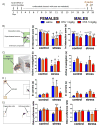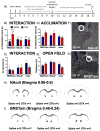Oxytocin Receptors in the Anteromedial Bed Nucleus of the Stria Terminalis Promote Stress-Induced Social Avoidance in Female California Mice
- PMID: 29066224
- PMCID: PMC5743604
- DOI: 10.1016/j.biopsych.2017.08.024
Oxytocin Receptors in the Anteromedial Bed Nucleus of the Stria Terminalis Promote Stress-Induced Social Avoidance in Female California Mice
Erratum in
-
Erratum.Biol Psychiatry. 2018 Feb 1;83(3):296. doi: 10.1016/j.biopsych.2017.11.009. Biol Psychiatry. 2018. PMID: 29277192 No abstract available.
Abstract
Background: The neuropeptide oxytocin (OT) is a key regulator of social and emotional behaviors. The effects of OT are context dependent, and it has been proposed that OT increases the salience of both positive and negative social cues. Here we tested whether the bed nucleus of the stria terminalis (BNST) mediates anxiogenic effects of OT.
Methods: First, we studied the effects of systemic administration of an OT receptor (OTR) antagonist L-368,899 on social behavior in male and female California mice exposed to social defeat. We examined the effect of L-368,899 on G protein activation and used early growth response factor 1 immunohistochemistry to identify potential sites of OTR action. Finally, we examined the effects of L-368,899 infused in the BNST on behavior.
Results: A single dose of systemic L-368,899 increased social approach in stressed female mice and decreased social approach in male mice naïve to defeat. L-368,899 prevented OT activation of G proteins and did not activate G proteins in the absence of OT. Intranasal OT, which reduces social approach in female mice but not male mice, increased early growth response factor 1 immunoreactivity in the nucleus accumbens core and anteromedial BNST in female mice but not in male mice. Stressed female mice that received an infusion of L-368,899 into the anteromedial BNST but not the nucleus accumbens core increased social approach and decreased social vigilance responses.
Conclusions: Our results suggest that OTR activation in anteromedial BNST induces a vigilance response in which individuals avoid, yet attend to, unfamiliar social contexts. Our results suggest that OTR antagonists may have unappreciated therapeutic potential for stress-induced psychiatric disorders.
Keywords: Bed nucleus of stria terminalis; Oxytocin; Sex differences; Social anxiety; Social defeat; Stress.
Copyright © 2017 Society of Biological Psychiatry. Published by Elsevier Inc. All rights reserved.
Figures






References
-
- Heinrichs M, Gaab J. Neuroendocrine mechanisms of stress and social interaction: implications for mental disorders. Curr Opin Psychiatry. 2007;20:158–162. - PubMed
-
- Neumann ID, Slattery DA. Oxytocin in General Anxiety and Social Fear: A Translational Approach. Biol Psychiatry. 2016;79:213–221. - PubMed
-
- Domes G, Heinrichs M, Gläscher J, Büchel C, Braus DF, Herpertz SC. Oxytocin attenuates amygdala responses to emotional faces regardless of valence. Biol Psychiatry. 2007;62:1187–1190. - PubMed
Publication types
MeSH terms
Substances
Grants and funding
LinkOut - more resources
Full Text Sources
Other Literature Sources
Medical

